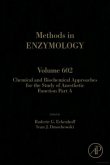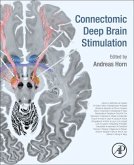Chemical and Biochemical Approaches for the Study of Anesthetic Function Part B
Herausgegeben:Eckenhoff, Roderic; Dmochowski, Ivan
Chemical and Biochemical Approaches for the Study of Anesthetic Function Part B
Herausgegeben:Eckenhoff, Roderic; Dmochowski, Ivan
- Gebundenes Buch
- Merkliste
- Auf die Merkliste
- Bewerten Bewerten
- Teilen
- Produkt teilen
- Produkterinnerung
- Produkterinnerung
Chemical and Biochemical Approaches for the Study of Anesthetic Function, Part B, Volume 603, presents a coherent description of the campaign towards understanding anesthesia. It includes a variety of highly debated topics, including sections on computational approaches, best practices for simulating ligand-gated ion channels interacting with general anesthetics, computational approaches for studying voltage-gated ion channels modulation by general anesthetics, anesthetic parameterization, the kinetic modeling of electrophysiology data, evolving biophysical technologies, fluorescent…mehr
Andere Kunden interessierten sich auch für
![Chemical and Biochemical Approaches for the Study of Anesthetic Function, Part A Chemical and Biochemical Approaches for the Study of Anesthetic Function, Part A]() Chemical and Biochemical Approaches for the Study of Anesthetic Function, Part A119,99 €
Chemical and Biochemical Approaches for the Study of Anesthetic Function, Part A119,99 €![Connectomic Deep Brain Stimulation Connectomic Deep Brain Stimulation]() Connectomic Deep Brain Stimulation118,99 €
Connectomic Deep Brain Stimulation118,99 €![Brain Edema Brain Edema]() Brain Edema83,99 €
Brain Edema83,99 €![Biomarkers in Bipolar Disorders Biomarkers in Bipolar Disorders]() Biomarkers in Bipolar Disorders100,99 €
Biomarkers in Bipolar Disorders100,99 €![Applications of Advanced Omics Technologies: From Genes to Metabolites Applications of Advanced Omics Technologies: From Genes to Metabolites]() Applications of Advanced Omics Technologies: From Genes to Metabolites148,99 €
Applications of Advanced Omics Technologies: From Genes to Metabolites148,99 €![Biomarkers of Postpartum Psychiatric Disorders Biomarkers of Postpartum Psychiatric Disorders]() Biomarkers of Postpartum Psychiatric Disorders100,99 €
Biomarkers of Postpartum Psychiatric Disorders100,99 €![Catalog of the Neurological Mutants of the Mouse Catalog of the Neurological Mutants of the Mouse]() Richard L. SidmanCatalog of the Neurological Mutants of the Mouse60,00 €
Richard L. SidmanCatalog of the Neurological Mutants of the Mouse60,00 €-
-
-
Chemical and Biochemical Approaches for the Study of Anesthetic Function, Part B, Volume 603, presents a coherent description of the campaign towards understanding anesthesia. It includes a variety of highly debated topics, including sections on computational approaches, best practices for simulating ligand-gated ion channels interacting with general anesthetics, computational approaches for studying voltage-gated ion channels modulation by general anesthetics, anesthetic parameterization, the kinetic modeling of electrophysiology data, evolving biophysical technologies, fluorescent anesthetics, lipids, membranes and pressure reversal, in vivo technologies, and more.
Produktdetails
- Produktdetails
- Methods in Enzymology Volume 603
- Verlag: Academic Press / Elsevier Science & Technology
- Artikelnr. des Verlages: S0076-6879(18)X0005-6
- Englisch
- Abmessung: 19mm x 152mm x 229mm
- Gewicht: 610g
- ISBN-13: 9780128145746
- Artikelnr.: 49668743
- Herstellerkennzeichnung Die Herstellerinformationen sind derzeit nicht verfügbar.
- Methods in Enzymology Volume 603
- Verlag: Academic Press / Elsevier Science & Technology
- Artikelnr. des Verlages: S0076-6879(18)X0005-6
- Englisch
- Abmessung: 19mm x 152mm x 229mm
- Gewicht: 610g
- ISBN-13: 9780128145746
- Artikelnr.: 49668743
- Herstellerkennzeichnung Die Herstellerinformationen sind derzeit nicht verfügbar.
Originally aspiring to be a marine biologist while at the University of Miami, Rod elected instead to join the ranks in hyperbaric medicine after graduating from Northwestern University Medical School. Since the only formal training program existed in the military, he became a US Naval officer, ultimately spending most of his time performing hyperbaric medicine research at the Naval Submarine Medical Research Laboratory in Groton, CT. Aiming to continue in this area, but in a more academic setting, he returned to civilian life as an anesthesia resident at the University of Pennsylvania, in large part because of the renowned Institute for Environmental Medicine at Penn. But the ability to more definitively answer questions persuaded Dr. Eckenhoff to pursue basic science training in the Andrew Somlyo lab at Penn., where he accidently discovered an approach to measure subcellular concentrations of anesthetics. This launched him in an entirely new direction, ultimately discovering a
nesthetic photolabeling, and adapting a series of traditionally biophysical approaches to the study of anesthetic mechanisms. Receiving his first NIH grant in 1991, Dr. Eckenhoff assembled an interdisciplinary group to study anesthetic mechanisms, and just a few years later, led a program project grant to funding on the first attempt. This grant is now in its 18th year and has evolved to now include seven different institutions across the country. The study of anesthetic mechanisms opened new doors into adverse effects, such as possible interactions with Alzheimer neuropathology, an issue that has gained considerable traction over the past decade. Finally, Dr. Eckenhoff has had the privilege of mentoring dozens of outstanding physicians, physician/scientists and basic scientists over the last thirty years.
nesthetic photolabeling, and adapting a series of traditionally biophysical approaches to the study of anesthetic mechanisms. Receiving his first NIH grant in 1991, Dr. Eckenhoff assembled an interdisciplinary group to study anesthetic mechanisms, and just a few years later, led a program project grant to funding on the first attempt. This grant is now in its 18th year and has evolved to now include seven different institutions across the country. The study of anesthetic mechanisms opened new doors into adverse effects, such as possible interactions with Alzheimer neuropathology, an issue that has gained considerable traction over the past decade. Finally, Dr. Eckenhoff has had the privilege of mentoring dozens of outstanding physicians, physician/scientists and basic scientists over the last thirty years.
Computational approaches
1. Physical accuracy leads to biological relevance: Best practices for simulating ligand-gated ion channels interacting with general anesthetics
2. Computational approaches for studying voltage-gated ion channels modulation by general anesthetics
3. Anesthetic parameterization
4. Pharmacophore QSAR, QM, ONIOM
5. Kinetic modeling of electrophysiology data
Genetics and model organisms
6. General genetic strategies
7. Worms
8. Flies
9. Tadpoles
10. Zebrafish
11. Mice
Photolabeling
12. Mass spect ID of adducts
13. Photolabeling protection/competition
Xenon
14. Xenon-protein interactions
15. Xenon gas delivery/recovery procedures
16. Hyperpolarized Xe-129 MRI
17. CT imaging
Electrophysiology
18. Native system electrophysiology (slices, cells, in vivo)
19. Voltage-gated ion channels (Kv, Nav)
20. Ligand-gated ion channels
21. Other channels (HCN/K2P/TRP)
Structural Approaches
22. Soluble proteins
23. Membrane proteins
24. NMR
25. Time-Resolved Neutron Interferometry and the Mechanism of Electromechanical Coupling in Voltage-Gated Ion Channels
Evolving Biophysical Technologies
26. Fluorescent Anesthetics
27. Investigation of anesthetic-protein interactions by a thermodynamic approach
28. Tissue/organism EPR
29. Lipids, Membranes and Pressure reversal
In vivo technologies; established and evolving
30. Optoanesthesia
31. Optogenetics, Chemogenetics
32. Genetic reporters of neuronal activity: c-fos, genetically encoded calcium indicators
33. Genomics and Proteomic Techniques
34. Neurochemistry of Anesthetic States
35. Electroencephalography
36. PET
37. Drug discovery and development
38. The use of glutamatergic anesthetics (ketamine, nitrous oxide and xenon) in depression
39. Brain Imaging Using Hyperpolarized 129Xe MRI
1. Physical accuracy leads to biological relevance: Best practices for simulating ligand-gated ion channels interacting with general anesthetics
2. Computational approaches for studying voltage-gated ion channels modulation by general anesthetics
3. Anesthetic parameterization
4. Pharmacophore QSAR, QM, ONIOM
5. Kinetic modeling of electrophysiology data
Genetics and model organisms
6. General genetic strategies
7. Worms
8. Flies
9. Tadpoles
10. Zebrafish
11. Mice
Photolabeling
12. Mass spect ID of adducts
13. Photolabeling protection/competition
Xenon
14. Xenon-protein interactions
15. Xenon gas delivery/recovery procedures
16. Hyperpolarized Xe-129 MRI
17. CT imaging
Electrophysiology
18. Native system electrophysiology (slices, cells, in vivo)
19. Voltage-gated ion channels (Kv, Nav)
20. Ligand-gated ion channels
21. Other channels (HCN/K2P/TRP)
Structural Approaches
22. Soluble proteins
23. Membrane proteins
24. NMR
25. Time-Resolved Neutron Interferometry and the Mechanism of Electromechanical Coupling in Voltage-Gated Ion Channels
Evolving Biophysical Technologies
26. Fluorescent Anesthetics
27. Investigation of anesthetic-protein interactions by a thermodynamic approach
28. Tissue/organism EPR
29. Lipids, Membranes and Pressure reversal
In vivo technologies; established and evolving
30. Optoanesthesia
31. Optogenetics, Chemogenetics
32. Genetic reporters of neuronal activity: c-fos, genetically encoded calcium indicators
33. Genomics and Proteomic Techniques
34. Neurochemistry of Anesthetic States
35. Electroencephalography
36. PET
37. Drug discovery and development
38. The use of glutamatergic anesthetics (ketamine, nitrous oxide and xenon) in depression
39. Brain Imaging Using Hyperpolarized 129Xe MRI
Computational approaches
1. Physical accuracy leads to biological relevance: Best practices for simulating ligand-gated ion channels interacting with general anesthetics
2. Computational approaches for studying voltage-gated ion channels modulation by general anesthetics
3. Anesthetic parameterization
4. Pharmacophore QSAR, QM, ONIOM
5. Kinetic modeling of electrophysiology data
Genetics and model organisms
6. General genetic strategies
7. Worms
8. Flies
9. Tadpoles
10. Zebrafish
11. Mice
Photolabeling
12. Mass spect ID of adducts
13. Photolabeling protection/competition
Xenon
14. Xenon-protein interactions
15. Xenon gas delivery/recovery procedures
16. Hyperpolarized Xe-129 MRI
17. CT imaging
Electrophysiology
18. Native system electrophysiology (slices, cells, in vivo)
19. Voltage-gated ion channels (Kv, Nav)
20. Ligand-gated ion channels
21. Other channels (HCN/K2P/TRP)
Structural Approaches
22. Soluble proteins
23. Membrane proteins
24. NMR
25. Time-Resolved Neutron Interferometry and the Mechanism of Electromechanical Coupling in Voltage-Gated Ion Channels
Evolving Biophysical Technologies
26. Fluorescent Anesthetics
27. Investigation of anesthetic-protein interactions by a thermodynamic approach
28. Tissue/organism EPR
29. Lipids, Membranes and Pressure reversal
In vivo technologies; established and evolving
30. Optoanesthesia
31. Optogenetics, Chemogenetics
32. Genetic reporters of neuronal activity: c-fos, genetically encoded calcium indicators
33. Genomics and Proteomic Techniques
34. Neurochemistry of Anesthetic States
35. Electroencephalography
36. PET
37. Drug discovery and development
38. The use of glutamatergic anesthetics (ketamine, nitrous oxide and xenon) in depression
39. Brain Imaging Using Hyperpolarized 129Xe MRI
1. Physical accuracy leads to biological relevance: Best practices for simulating ligand-gated ion channels interacting with general anesthetics
2. Computational approaches for studying voltage-gated ion channels modulation by general anesthetics
3. Anesthetic parameterization
4. Pharmacophore QSAR, QM, ONIOM
5. Kinetic modeling of electrophysiology data
Genetics and model organisms
6. General genetic strategies
7. Worms
8. Flies
9. Tadpoles
10. Zebrafish
11. Mice
Photolabeling
12. Mass spect ID of adducts
13. Photolabeling protection/competition
Xenon
14. Xenon-protein interactions
15. Xenon gas delivery/recovery procedures
16. Hyperpolarized Xe-129 MRI
17. CT imaging
Electrophysiology
18. Native system electrophysiology (slices, cells, in vivo)
19. Voltage-gated ion channels (Kv, Nav)
20. Ligand-gated ion channels
21. Other channels (HCN/K2P/TRP)
Structural Approaches
22. Soluble proteins
23. Membrane proteins
24. NMR
25. Time-Resolved Neutron Interferometry and the Mechanism of Electromechanical Coupling in Voltage-Gated Ion Channels
Evolving Biophysical Technologies
26. Fluorescent Anesthetics
27. Investigation of anesthetic-protein interactions by a thermodynamic approach
28. Tissue/organism EPR
29. Lipids, Membranes and Pressure reversal
In vivo technologies; established and evolving
30. Optoanesthesia
31. Optogenetics, Chemogenetics
32. Genetic reporters of neuronal activity: c-fos, genetically encoded calcium indicators
33. Genomics and Proteomic Techniques
34. Neurochemistry of Anesthetic States
35. Electroencephalography
36. PET
37. Drug discovery and development
38. The use of glutamatergic anesthetics (ketamine, nitrous oxide and xenon) in depression
39. Brain Imaging Using Hyperpolarized 129Xe MRI








